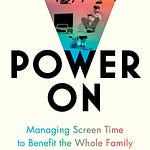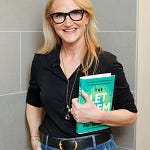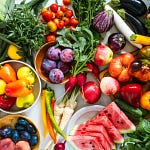You're listening to Burnt Toast. I'm Virginia Sole-Smith and I also write the Burnt Toast newsletter.
It’s been over nine months of the official Burnt Toast Podcast — over a year if you count all the beta testing I did with audio before that. So we’ve more than made the baby and we’ve been reflecting a bit on what’s working and what we’d like to do better. And one thing I’ve realized: Having a guest every single week is not a sustainable pace. I want more time in between interviews to research and prepare, so I can make sure I’m bringing you the best of what those conversations can be. So we’re shifting things around a bit, and you’re going to get a few more Corinne and Me episodes, which I know everyone is excited about, and a few more Just Me episodes, which I hope we’ll be excited about!
So what we’re going to do today is revisit an old piece from the newsletter, that is actually the most popular piece I’ve ever written. It ran last September and it’s called Please Stop Romanticizing Your Child’s Lunchbox.
I’m going to read the piece first and then discuss a little bit of the reaction that this piece received, and where I’m landing on school lunch now, a year later. Before we start, I should note that this piece had a really awkward intro because I wrote it back when I was still figuring out my newsletter format. So I’m going to skip over the housekeeping bits at the top that aren’t relevant.
Also! I recorded this episode before yesterday’s White House Conference on Hunger, Nutrition, and Health. There is a lot to say about the conference and the Biden administration’s new National Strategy — how much it’s shades of Michelle Obama’s Let’s Move campaign, how it’s automatically treating “ob*sity” as a disease despite the lack of evidence that this approach improves health and the significant evidence that it promotes anti-fat bias— and I’m sifting through all of that to figure out how to cover it. But for our purposes today, it’s worth noting that Biden’s plan does include a promise to “advance a pathway to free, healthy school meals for all.” Which could (should!) mean a return to universal free school lunch. They aren’t overly optimistic about the timeline; the report notes that they “will take a major first step by working with Congress to expand access to healthy, free school meals for 9 million more children by 2032.” But at least free school lunch is back on the agenda in a concrete way, along with several other important anti-hunger legislative goals.
Breaking BT Giving Circle News
I haven’t talked about the Burnt Toast Giving Circle in a minute and we are in the final push towards November — and so close to our new goal of $30,000. If you haven’t donated yet, now is a critical time to do so. An urgent situation has come up in Arizona (where we’re fighting for a blue majority in state government): The unopposed Democratic state senate candidate in LD 22, Rep. Diego Espinoza, dropped out of the race to take a lobbying job without giving notice to the party.
It's too late to get his name off the ballot, so there has to be a coordinated effort to educate Dem voters NOT to vote for him (votes for him will not count) but instead to WRITE IN the new candidate's name: Dr. Evangeline Diaz, who was vetted and chosen by the States Project’s on-the-ground partner in Arizona, the ADLCC.
The States Project needs to raise an additional $50,000 for the program in Arizona THIS WEEK to make sure that there are new resources for this unexpected district play. Those dollars will go to layered voter-contact tactics like write-in explainer mailers, digital communication, and a field team to educate voters in the district about what needs to be done in the ballot box.
There are 51 Giving Circles focused on Arizona, so if each of us raises just $1,000 we can make this happen. The time to act is now — mail-in ballots go out on October 12.
Please Stop Romanticizing Your Child’s Lunchbox
(This is a reprint of last year’s essay, with a few new additions in footnotes. If you read it before, just scroll down for the rest of the episode’s analysis and your Butter recs!)
Back in April 2021, the USDA announced that it would extend a waiver that allows schools to serve free meals to all students through the entire 2021-2022 school year. Families no longer have to apply or demonstrate eligibility for free lunches in most districts; cafeterias are just feeding every kid who shows up for lunch. This effort started as a response to the pandemic-fueled increase in childhood hunger, as I reported for the New York Times last year. And anti-hunger advocates are hoping to make it a permanent change by getting Congress to pass the Universal School Meals Act.1 So we are now officially back to school in every district in the nation, and most kids are walking into a radically different cafeteria than ever before.
There are some nuances to this, of course. “Please note that USDA is not providing a free universal meal program,” a USDA spokesperson told me via email because I guess the government never wants to look like it’s caring too much. States have to opt in to the waiver before schools can serve free meals to all; otherwise they can participate in the normal National School Lunch Program, where kids pay full price, reduced price, or nothing based on their family’s income eligibility (meaning schools and families still have to do that application process).
And some, such as the Waukesha School District in Wisconsin, have opted not to participate. In that case, it was because school board members worried that feeding kids lunch would make them “spoiled” and also, rather inexplicably, pave the way to mask mandates. (The school district has since reversed that decision.) The USDA does not yet have data on how many districts around the country opted in or out, but the same spokesperson confirmed that “the majority” of states are in. So we can expect to see a big spike in participation numbers from the last time this data was collected, in 2014-2015, when just one in five schools offered free lunch to all students. I also did some extremely un-scientific Instagram polling (on my own account, and then I borrowed Yummy Toddler Food’s much larger one), 81 to 89 percent of followers who voted said lunch is free at their kids’ school this year.
Unless you are a heartless Wisconsin school board member, universal free lunch is unequivocally great for the estimated 12 million American kids who can’t get enough to eat at home. There is no debate about that (which is why we should have been doing it for decades already). But what if you don’t have a financial need for school lunch? The real question—that may very well determine whether or not universal free lunch becomes a permanent part of the American education system—is: Will Nice White Parents let our kids eat school food?
So far, the answer appears to be: An awful lot of us won’t. “Roughly 20 million eligible children, mostly from middle- and upper-middle-class families, continue to opt out of the national program by bringing lunch or by buying special à la carte food items not covered by the program,” wrote Jennifer Gaddis, PhD, an assistant professor at the University of Wisconsin and author of The Labor of Lunch, in a New York Times op-ed from February 2020. We don’t yet have data on how the shift to free lunch will change that for this school year, so I once again turned to Instagram for more insight. In my (again, totally unscientific!) poll of 210 parents, 49 percent of parents said yep, their kids are eating the free school lunch, and 51 percent said no, they are still sending in lunchboxes. In other words: Just over half of this group of parents are paying for a meal—and investing time and labor in preparing said meal—that their children could be eating for free.
I suspect the vast majority of these folks were horrified by that Wisconsin school board. These are parents who support free lunch programs, in theory, at least, for other kids. Indeed, some said they didn’t want to take free lunch away from kids who need it. But the reality is that participation rates drive this program’s funding: “When millions of families [pack lunch], their actions reduce the political will and financial resources necessary to make public school lunches better for everyone,” wrote Gaddis last year. I checked in with Gaddis yesterday and she confirmed that this is still true, even though lunch is now free. The federal government reimburses schools per student eating lunch and they reimburse at the highest rate per students eating for free, so schools can now receive the maximum subsidy.2
Perhaps even more important: When lunch is free for everyone, then the kids who need free lunch aren’t stigmatized by the kids who don’t. “You can often see huge divides along income and racial lines in cafeterias between the kids who get free lunch and the kids who bring lunch from home,” notes Gaddis. “If we want to create spaces in our schools that are inclusive and welcoming for all, participation really matters. When people with the economic means opt out of school lunch, it sends the message to policy makers that this is a program they don’t really have to care about.”
So why aren’t more parents—especially progressive parents—sending their kids to the lunch line? Diet culture has taught us that school lunches aren’t good enough for our kids. I asked the lunch-packers for follow-up and this lesson came through explicitly in about 14 percent of my respondents, and was implied by many more. “While the lunch is free, it’s not actually healthy and I like knowing my kids aren’t eating junk,” said one mom. In fact, school lunches are pretty darn healthy: A 2018 analysis of over 16 years of data concluded that schools “are now the single healthiest place Americans are eating.” This shift is due, in large part, to the 2010 Healthy and Hunger-Free Kids Act, championed by Michelle Obama, which overhauled school nutrition standards and changed the nutritional intake of school children in several important ways.
And, as Gaddis argued in her piece, with more kids eating, school lunches could get even healthier: “The food-service director of the Austin Independent School District, Anneliese Tanner, told a local news outlet that the district could afford to serve grass-fed beef if the kids who currently opt out of the national program would eat school lunch just once a week.” (Tanner is now the director of research and assessment at the Chef Ann Foundation, a nonprofit dedicated to helping schools do more from-scratch cooking.)
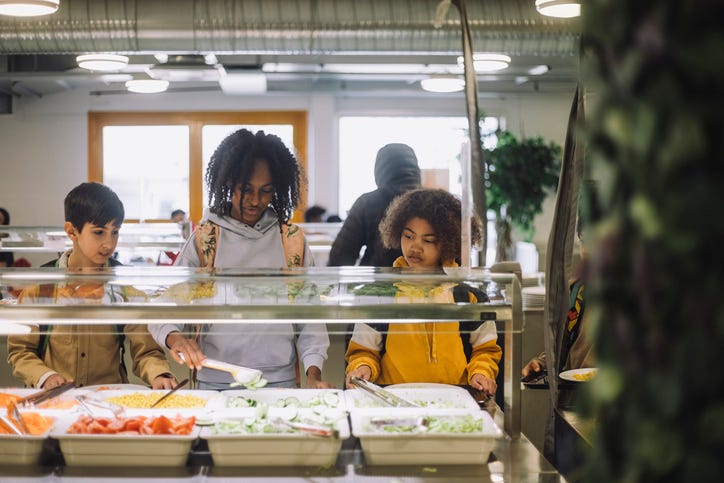
But no, cafeteria meals likely won’t pass muster if your definition of healthy comes from diet culture. “We eat plant-based,” or, “There aren’t enough whole foods” came up a lot in my Instagram DMs. See also: “Kid says school lunch tastes like plastic,” and many similar comments equating school food with “processed food,” “fast food,” or “diner food.” And it’s not just my followers. In Royal Oaks, Michigan, parents protested when the elementary school’s free lunch included grab-and-go items like bagged Goldfish crackers and Scooby-Doo Graham Cracker Sticks. And the Chef Ann Foundation where Tanner now works had to apologize recently after posting a meme unfavorably comparing school meals to ultra-processed foods.
It’s also true, as Bettina Elias Siegel reported last week (CW for o-words), that due to Covid restrictions, labor shortages, and supply chain issues, many schools have been forced to switch out hot meals for grab-and-go lunches. Gaddis acknowledges that these issues may be impacting menu composition right now: “What you’re likely to find in a typical cafeteria right now is more processed food and less scratch cooking than you would have seen pre-pandemic,” she says. And, Covid or not, many schools incorporate processed foods into their meals, both because such foods are cheap and convenient when you’re mass-producing meals (and don’t have the budget to hire experienced school cooks), and because their pre-printed nutrition labels make it easy to ensure they are meeting complex government nutritional standards. But Graham Cracker Sticks are not our enemy. Nutrition perfectionism is.
As I’ve written before, the problem with processed foods isn’t their ingredient lists; it’s our culture’s dysfunctional relationship with them. Your fear of snack crackers is a big reason why your kid seems so obsessed with them. Letting kids eat these foods at school, alongside the fruits, vegetables, and other foods that school districts are also required to serve, could be a great way to lessen a child’s scarcity mindset around them.
But to do that, we have to sift through the layers of classism and racism that underpin our feeling that kids eating “fast food” for lunch is proof of lazy or bad parenting. Many parents who are using school lunch this year told me that they feel guilty for taking such an “easy” way out, as if letting your child eat the same meal that another kid has no choice but to eat is being a #badmom. Meanwhile, one school lunch abstainer wrote that she has “been dreaming about packing lunches for kids 4ever ♥️.” Instagram, Pinterest, and the rise of the momfluencer has turned school-lunch packing into a cross between competitive sport and creative self-care practice. We’re flooded with images of $60 PlanetBoxes and $42 OmieBoxes, rainbow produce cut into stars and hearts, and the message that all of this is a valid measure of our mothering. But that’s only true if your definition of motherhood is almost exclusively white and upper-income.
Possibly related: Around 40 percent of my followers said they were skipping school lunch because “my kid won’t eat it.” As the parent of one child with a traumatic feeding history, and another doing the typical picky preschooler thing, I absolutely feel this. But within this “picky” group, I noticed that responses ranged from “ARFID! She needs her safe foods,” to a more shrugging, “My kid doesn’t like it.” I wonder here whether it’s always the kid who doesn’t like the food, or the parent, or the kid internalizing a parent’s rigid standards. Children with true feeding disorders or other sensory challenges do need extra support and may be overwhelmed by trying to eat in a cafeteria setting. And, of course, kids with food allergies, especially life-threatening ones, may need a packed lunch to eat safely. (That group made up about 8 percent of my respondents.)
But: Our more garden-variety picky eaters may get more adventurous in the cafeteria than you’ll ever see at home. Research shows that kids tend to eat a larger variety of foods when they get repeated exposures to them in a peer setting, as Sally Sampson and Natalie Digate Muth, M.D., wrote for the New York Times back in 2015. This is also another reason not to freak out about processed foods on school lunch menus; Goldfish and the like are often the familiar, predictable foods that cautious kids need to use as stepping stones and to feel empowered when navigating a new eating situation.
About one-fifth of the parents in my poll said they took a hybrid approach, letting kids study weekly school lunch menus and decide which days to bring or “buy.” Gaddis and I agree that this seems like a great work-around for most picky kids because it lets them build confidence eating in a new setting with foods they like, and still encourages involvement in school meals—which benefits everyone. Some of this group even require kids to pack lunch themselves on the days they don’t want to eat the school meal, which is a rather genius way to get kids more involved in their own meal planning mental load.
I also heard from a vocal minority of parents who really want to do school lunches but have opted out because of logistical issues, especially long lines that don’t leave their kids time to eat (especially in places limiting lunch periods to 15 minutes right now to reduce Covid risk). I too worry about kids who need to stand in line, eat, and get to the bathroom during this timeframe—solidarity to all the kindergarten teachers dealing with afternoon wet pants! If a lunch logistic is your deal-breaker this year, Gaddis says, “Just don’t make this your permanent decision about school lunch.” And do contact your elected officials and let them know that you want them to support the Universal School Meals Act and several other pieces of legislation pending now.
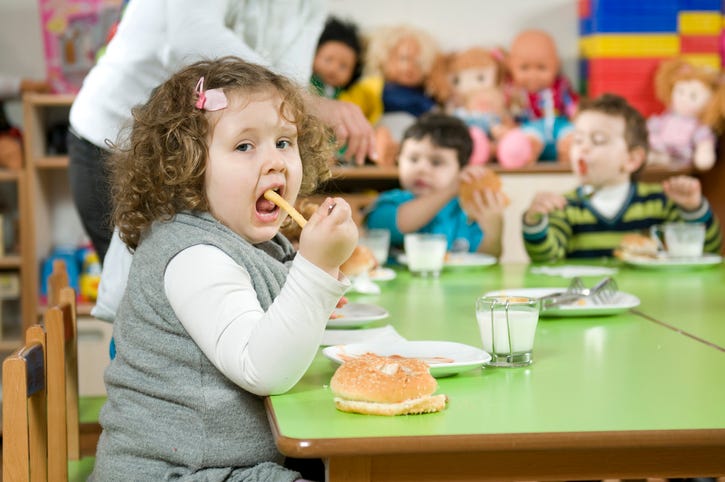
So no, school lunch is not perfect. But the problems likely aren’t what you think. And it could be so much better if we started to shift away from this diet culture-fueled hierarchy of kid lunches, with cafeteria trays always on the bottom. Letting go of these standards for perfect kid lunches and perfect parenthood is hard. More than one mom told me they pack lunch because, “This way I know what food she’s offered,” or, even more bluntly, “I like the control.” But our kids will have a healthier relationship with food in general if we empower them to eat this meal without our micromanagement. Releasing some of this control can be a way to let our kids know we trust them; to encourage their curiosity; to enable more community building in cafeterias, instead of dividing kids up into those with lunchboxes and those without. This could be how we turn school meals into something different, and better. And probably, still containing Graham Cracker Sticks.
Essay Discussion
So there were several threads to the reaction to this piece that are interesting to discuss a year later. One: I heard from many parents of picky eaters and parents of kids with true feeding challenges who said that eating school lunch has been really helpful for their kids. It can be more neutral place to try new foods than the family dinner table. And because school lunches are designed to be kid-friendly, they often do feature foods that selective eaters do well with. This is not to say that school lunch will work for every selective eater – but don’t rule it out as an option full stop just because you have a picky kid. It can absolutely be a helpful tool.
A lot of you also told me about the logistical issues with your school’s lunch program that make buying lunch too hard. Super short lunch times, long lines, even food shortages in many districts. That was particularly hard during the pandemic and I get it if you packed lunch for your kids under those circumstances. But I do think those of us with the privilege to pack should not check out of those issues completely. We still need to be thinking of lunch as a school community event that we all participate in and work on.
But the really fascinating thing is how many comments I get—and this just happened on Instagram when I did a repost of this piece at the start of September—from people saying they can’t buy school lunch because the food isn’t healthy and is too processed or has too much sugar. This is the whole problem. We have to stop defining “healthy” as a plate full of fresh vegetables. Lunch does not need to be a salad to get a gold star. Most kids won’t even eat a salad. (Also plenty of schools serve salad!)
We can define a healthy lunch as a meal that kids are able to navigate themselves, as a meal where they share food with their community, as a meal where they can get full enough and get the energy they need to learn and play the rest of the school day. All of that can come in the form of an Uncrustable. We don’t need to make this so hard.
The last thing I want to talk about is what we’re doing in my house, this year, for school lunch. One thing I didn’t share when I wrote the piece last year was that my kids were attending a small private school that didn’t offer a lunch program. This was a super hard decision that we made during Covid due to my older daughter’s high risk status—and it was absolutely a decision we were able to make due to a pile of privilege. But let me tell you how much I missed the school lunch program during the two years we spent there!
This year, we are so happy to be back at public school. Our school, like many schools, is no longer offering free universal lunch because the federal government program expired June 30. So we are paying $3.10 per lunch and I am happy to do it. My younger daughter buys every day and gets the exact same thing every day; Peanut butter and jelly and chocolate milk plus whatever fruit they have that day. The first day she told me she ate mango and carrots, and believe me when I say those are two foods she has never willingly eaten at home.
My older daughter, who is more selective and also more independent at age 9, is studying the cafeteria menu each week and buying some days and packing her own lunch some days. I told her she could make that decision as long as she packs her lunch herself—because I know if she forgets, she can eat the cafeteria PB&J even if it’s not her favorite. (She has opinions about the thickness of their bread.) And this is working really well for her because she loves the control of picking her own lunch. We also had some good conversations about the importance of the school lunch program and the role of privilege in packing. So she is buying less frequently than her sister, but still buying at least once or twice a week and I’ll call that a win for now.
Butter for Your Burnt Toast
You’re just getting my recs this week, but I’m giving you three of them! These are all things I did over Labor Day weekend, when I had my house to myself for THREE WHOLE DAYS and, as newsletter readers know, spent a lot of that time finishing my book and stress-organizing my kitchen. But that’s not all I did!
I read Tomorrow and Tomorrow and Tomorrow by Gabrielle Zevin, and loved it. Someone on Instagram compared it to A Little Life and I got scared, but can now reassure fellow literary-trauma-avoiders that it is NOT on that scale. (But yes there is heartbreak and loss.)
I went hiking with this amazing group and yes, I want to write more about that experience soon. (You can spy me here!)
I watched so many episodes of the new A League of Their Own and sobbed through the last two. Fervently hoping for season 2.
OK, that’s our show! Thanks so much for listening to Burnt Toast.
If you liked this episode, please rate and review us in your podcast player. And consider subscribing to the Burnt Toast newsletter. Reader subscriptions are what enable me to make this podcast and report essays like the one I just read. And subscriptions are on sale this week!
The Burnt Toast podcast is produced and hosted by me, Virginia Sole-Smith. You can follow me on Instagram and Twitter at @v_solesmith.
Our transcripts are edited and formatted by Corinne Fay, who runs @SellTradePlus, an Instagram account where you can buy and sell plus size clothing.
The Burnt toast logo is by Deanna Lowe.
Our theme music is by Jeff Bailey and Chris Maxwell
And Tommy Harron is our audio engineer.
Thanks for listening and supporting independent anti-diet journalism!
Spoiler alert: it did not pass.
Again, that is from last year when school lunches were free. Now that most school districts have done away with the free programs, we're back to the original plan, which is still that participation at all income levels drives the funding that school lunch programs receive.










